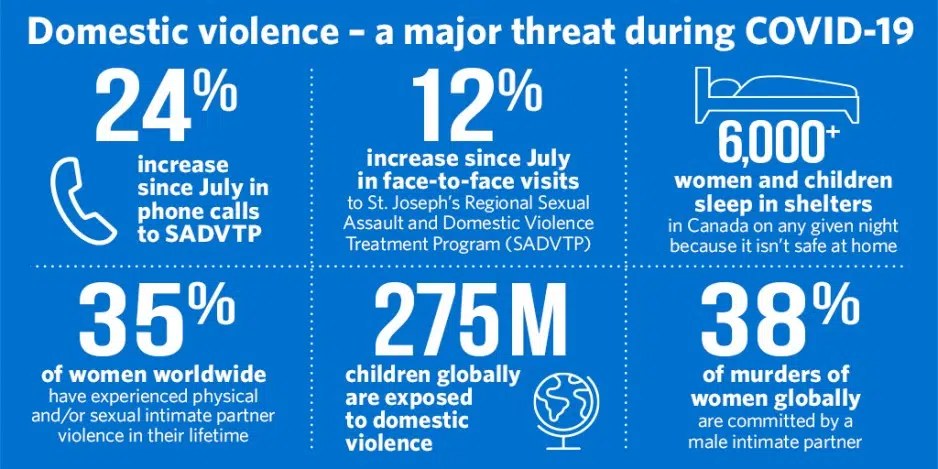The numbers highlight the bleak reality of domestic violence amid COVID-19.
St. Joseph’s Sexual Assault and Domestic Violence Treatment Program (SADTVP) has seen a 24% increase in calls, and a 12% increase in face-to-face visits, compared to this time last year. Those numbers have been steadily climbing since July.
According to Program Coordinator, Cassandra Fisher, the volume of calls wasn’t the only sign that domestic violence was worsening through the pandemic.
“The acuity of the domestic violence was a lot higher,” she said. “The violence was a lot more violent. The injuries were quite significant in comparison to what they had noticed in previous times.”
COVID-19 and domestic violence
Many of the psychological facets of abuse have been amplified by the pandemic. In addition to physical violence, which is not present in every abusive relationship, common tools of abuse include:
- isolation from friends, family and employment;
- constant surveillance;
- strict, detailed rules for behavior;
- and restrictions on access to such basic necessities as food, clothing and sanitary facilities.
All of these factors have come part and parcel with COVID-19, increasing their prevalence among domestic partner abuse.
Dr. Susan McNair is a physician at SADVTP, and said that certain anxieties brought on by the pandemic could be root of the increase in domestic violence.
“In any situation where there’s a pandemic and people are isolated, obviously difficulties already existing in relationships will be more augmented,” she said. “Issues of finances, issues of care, looking after children…anxiety amongst the family members trying to take care of elderly parents…which I think can erupt into interpersonal relationships.”
Many survivors of abuse are living with their partners, with little or no options for other places to go. The limitations brought about by the pandemic only increase the inescapability of an abusive relationship.
“Not just bruises and lacerations”
The facets of domestic violence that have been heightened by COVID-19 are mainly emotional and psychological. Under a pandemic, many things are out of our control, just as many of the more psychological facets of domestic violence are linked to manipulation and power over an individual’s actions.
“We talk about domestic violence and we often talk about the physical aspects of domestic violence, where in fact that’s only one facet of it,” said Dr. McNair. “I think it’s multi-dimensional really. When we talk about domestic violence, we have to be careful not to simply define it in terms of bruises and lacerations.”
 The issue of domestic violence goes far beyond London. 35% of women globally have experienced physical and/or sexual partner violence, while 275M children worldwide are exposed to domestic violence in their lifetimes.
The issue of domestic violence goes far beyond London. 35% of women globally have experienced physical and/or sexual partner violence, while 275M children worldwide are exposed to domestic violence in their lifetimes.
In terms of statistics through the pandemic, there has yet to be any significant research done on the effect of domestic violence among vulnerable groups, such as women of colour and transwomen. Though, Fisher said she believes the numbers would also be high.
“The groups that we are hoping to support and hope will come forward to us are those vulnerable populations, but ultimately they also tend to have the most barriers coming forward,” said Fisher.
Statistically, Indigenous women specifically are about 20% more likely to experience domestic violence compared to non-Indigenous women, pandemic or otherwise.
Services at St. Joseph’s
Fisher urged those in danger to seek out help from the SADVTP. She said in spite of the increase in numbers, their 24 hour service has been able to keep up with the demand.
SADVTP offers non-judgmental medical services, as well as assistance in contacting police, and phycological support. Special programs are also in place for those only seeking psychological care.
“We have a wonderful full time social worker and two part time social workers who assist with that care in the acute phase and in the months that follow,” said Dr. McNair.
Fisher added that all the care offered through SADVTP is patient-centered, meaning the patient has total control of the care they receive.
“They can choose to accept or not to,” said Fisher. “And it’s giving that empowerment back to them. They’ve had a lot of power taken away from them so this our first step in their healing process and kind of giving them that empowerment.”
For more information, visit St. Joseph’s Sexual Assault and Domestic Violence Treatment Program online.







